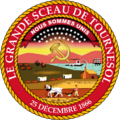Constitution of Tournesol
| Constitution of the Continental Republic of Tournesol | |
|---|---|
| Overview | |
| Jurisdiction | Tournesol |
| Ratified | 1 June 1921 |
| Date effective | 1 June 1921 |
| System | Federal Marxist-Landonist one-party socialist republic |
| Government structure | |
| Branches | Three (Legislative, Executive, Judicial) |
| Head of state | President |
| Chambers | Unicameral (National Assembly of Tournesol)[a] |
| Executive | Council of Ministers headed by the Premier of the Council of Ministers |
| Judiciary | Supreme People's Court |
| Federalism | Federation |
| Electoral college | Yes – the National Assembly, which elects all other state authorities, is itself elected by two layers of Indirect election: Commune and Canton People's Assemblies elect the members of Departmental/District People's Assemblies, who in turn elect the members of the National Assembly. |
| History | |
| First legislature | 10 August 1921 |
| First executive |
10 August 1921 (Chairman) 15 August 1921 (Premier) |
| First court | 11 September 1921 |
| Amendments | 12 |
| Last amended | 10 August 2021 |
| Location | Topèque |
| Commissioned by | Constituent Assembly |
| Supersedes | 1902 Constitution |
| Full text | |
|
| |
| Politics of Tournesol |
|---|
 |
|
Leadership |
|
Legislature |
|
Tournesol portal |
The Constitution of Tournesol, officially the Constitution of the Continental Republic of Tournesol (French: La Constitution de la République Continentale de Tournesol), is the supreme law of Tournesol. The constitution was first adopted in 1921 by the 1st National Assembly, which was modeled after the Constitution of the United Commonwealth. Further revisions and amendments have been made since its initial adoption. The current constitution is the fourth constitution to date in Tournesol's history.
The current constitution contains language and provisions describing the functions and powers of the Tourneser government and its state organs, the rights and duties of Tourneser citizens, the role and goal of socialism and Continentalism, and the centrality of the Continentalist Party of Labor. It also contains provisions concerning the distribution and division of power between the federal government and the departmental governments under the Tourneser system of federalism.
The adoption and promulgation of the Constitution is celebrated annually on 1 June as a public holiday, known as Constitution Day.
Structure
The Constitution consists of a preamble and six parts, with each part further subdivided into chapters, articles, and sections. The Constitution, outside of the preamble, refers to the country as simply the "Republic".
Preamble
The preamble to the Constitution contains an introductory statement expounding the objective of the Continental Republic of Tournesol in advancing towards communism, under the guiding principles of Marxism−Landonism and Continentalism, the popular sovereignty and will of the people, the triumph of the Revolution, and the fundamental values and virtues of the new Republic. It further proclaims the independence of Tournesol as a federation of departments, free from the control or influence of capitalist powers, and its commitment towards the eventual creation of a classless and stateless world order.
General Principles
The General Principles outline the fundamental and authoritative ideas and concepts which govern the basic framework of the Tourneser state. It asserts that the Continental Republic of Tournesol is to organized and structured as a socialist state, in conformance with orthodox Marxism–Landonism, Continentalism, and democratic centralism. It declares that supreme power rests with the working class and their party, the Continentalist Party of Labor. All power, according to the Constitution, emanates from the worker in both the countryside and the city. All representative bodies of the State are to owe their election, supervision, and accountability from the people. The General Principles also assert that Tourneser society shall be free of distinction or discrimination against one another on account of their sex, gender, race, color, ethnicity, ancestry, language, or religion.
Fundamental Rights
Structure of the State
The Party
Departments and Communes
National Symbols
Amendments
Previous constitutions
Wyandotte Constitution
1889 Constitution
1902 Constitution
Notes
- ↑ The de facto legislature is the Council of State